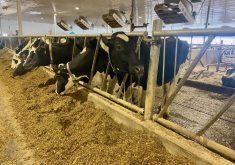We are enjoying your stories about pets. The deadline for entries for the draw is June 30. Tell us how your pet has become part of your life, the place they hold in your heart, and of their adventures or misadventures. Please send your stories to team@producer.com or mail them to The Western Producer at Box 2500, Saskatoon, Sask.
S7K 2C4.
We will make a draw for several prizes from all of the letters we have received. The Western Producer is providing four subscriptions to its Acreage Life magazine and Hills Petfood Food is donating an array of pet gifts. Also Atco Gas Blue Flame Kitchen is donating an all new Everyday Delicious cookbook and some insulated shopping bags.
Read Also

Powerful solar storm lights up night time sky
Prairie skywatchers have been on high alert the last few nights as spectacular aurora displays have made the night time…
In looking through the Everyday Delicious cookbook I thought this fish recipe would be good to try.
Wasabi crusted fish fillets
1 pound fish fillets 500 g
1/2 cup mayonnaise 125 mL
11/2 teaspoons wasabi 7 mL
paste
1/4 teaspoon salt 1 mL
1 cup panko (Japanese- 250 mL
style bread crumbs)
1/2 teaspoon paprika 2 mL
Pat fillets dry with paper towels. Combine mayonnaise, wasabi paste and salt; spread on both sides of fillets. Combine panko and paprika in a pie plate. Working with one piece at a time, dip fillets into panko mixture. Press lightly so that the panko mixture adheres, then turn to coat both sides. Place fillets in a single layer on a greased rimmed baking sheet. Bake, uncovered, at 450 F
(230 C) for 10-12 minutes per inch (2.5 cm) of thickness or until fish flakes easily with a fork. Serves four.
Wasabi, also known as Japanese horseradish, is available in paste and powder form. It is bright green.
Panko are bread crumbs used in Japanese cooking to make a crunchy coating for fried foods. They are coarser, crisper and airier than the fine, dry bread crumbs used in North American cooking.
Both of these ingredients can be found in Asian grocery stores or the Asian section of supermarkets.
The following is the Atco Blue Flame Kitchen version of panko.
Remove crust from one-quarter of a loaf of day-old French bread. Cut bread into one inch (2.5 cm) cubes. Using the shredding disc of a food processor, cut bread cubes to make coarse crumbs.
Spread crumbs out on a rimmed baking sheet. Bake at 300 F (150 C), stirring twice, for about six minutes or until crumbs are dry but not toasted. Makes about two cups (500 mL).
Weeping meringue
Dear TEAM: When I make meringue, after a day it gets weepy with droplets. How do I avoid this? – G.G., e-mail
Dear G.G.: There are a number of reasons why meringues get weepy. One is humidity. Meringues are
basically egg whites and sugar, and anything made with a lot of sugar will attract moisture. This causes small brown beads to form. So a steaming kettle, moist kitchen or humid day can cause the problem.
To reduce the problem, once the meringue has cooled, store it in an airtight container.
To avoid weepiness always put the meringue on a hot filling. The residual heat carried by the filling cooks the base of the meringue slightly, making it less prone to leaking or shrinking.
Another important factor in making meringues is to add the sugar slowly to the eggs whites and then beat well to dissolve the sugar. Consider using fruit sugar, which is finer in texture and dissolves more easily. Check that the sugar is dissolved by rubbing some meringue between your thumb and forefinger. If it feels gritty, beat a little longer.
It is easier to separate the eggs while they are still cold. Be sure no yolk slips in with the white because it will interfere with the foam formation. Once the eggs are separated, let the egg whites stand at room temperature for 20 minutes. They will whip to a greater volume than if beaten when cold.
Any fat or oil will also reduce the egg whites foaming so make sure bowls and beaters are clean and dry and use a glass or metal bowl.
When beating the egg whites, start at a low speed and increase speed as the whites become foamy and begin to stiffen. Stop when the whites are stiff but not dry. The sugar should be added when the egg whites have reached the soft-peak stage.
Adding a small amount of cream of tartar, 1/4 teaspoon (one mL) for four egg whites, will help to stabilize the foam. Add at the beginning of the beating. As soon as the meringue is beaten, spread it on the hot filling right to the edge of the pie crust or baking dish. This will help to keep the meringue from shrinking.
Basic soft meringue
4 large egg whites
salt
1/4 teaspoon cream of 1 mL
tartar
1/2 cup fruit sugar 125 mL
Preheat oven to 350 F (180 C).
Add a sprinkling of salt and cream of tartar to the egg whites; beat slowly, gradually increasing the speed. When soft peaks form, slowly add sugar and continue beating until stiff. Swirl onto pie being sure meringue touches the pastry. Bake until golden brown (15-20 minutes).
Variation: To make a meringue of fine texture, melt four marshmallows over hot water; beat into the meringue.
Source: The Joy of Cooking by Irma Rombauer, Marion Rombauer Becker and Ethan Becker.
Betty Ann Deobald is a home economist from Rosetown, Sask., and one of four columnists comprising Team Resources. Send correspondence in care of this newspaper, Box 2500, Saskatoon, Sask., S7K 2C4 or contact them at team@producer.com.














